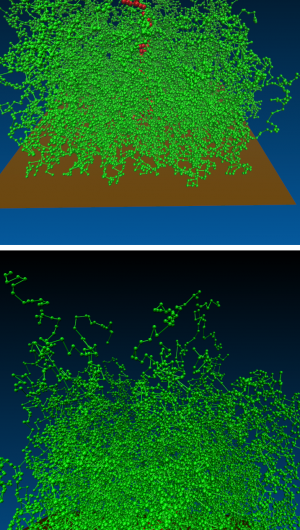August 15, 2014 report
Researchers discover a way to cause surface coating properties to change in less than a second

(Phys.org) —A team of researchers with members from Russia, Lebanon and Germany has found a way to cause a polymer coating to respond to environmental factors in just seconds, instead of the minutes or hours it takes for current polymers. In their paper published in the journal Physical Review Letters, the team describes how they came up with their technique and how it works.
Over the years, researchers have developed ways to create polymer coatings that change due to environmental factors—becoming more or less repulsive to water, for example, based on material present in a liquid. Such polymers are able to switch because of the way they are applied to a material—generally as strands or bristles, forming a brush-like outer covering. By applying two different types of bristles with different properties, it becomes possible to create a surface that reacts differently under different scenarios. If half the bristles stand up straight when exposed to temperatures above a certain point, for example, while the other half lay flat, then a coating will have a certain property above that temperature point. If the same half lies flat below another temperature point, while the other half stands up straight, then the coating will offer a different property. The problem comes during switching, because it involves one set of bristles standing up, and the other laying down—bundling can occur—the bristles can get caught up in one another taking some amount of time to get untwined—from minutes to hours. In this new effort, the researchers have found a way to make the changeover occur nearly instantaneously.
Instead of mixing two types of polymers half and half to make the two types of bristles, the researchers changed the proportion of one to the other, making more of one type of bristle and less of the other. The less numbered bristles could then be spread widely among the more dominant bristles preventing bundling during switching—the bristles were too far apart to twine. To make sure the non-dominant bristles didn't twine with the dominant bristles, the researchers made them 10 percent longer.
The end result is a polymer coating that can respond with very little time lag to an environmental change—in this case, to changes in temperature. The team acknowledges that the response by the non-dominant bristles don't change the surface much, but that could be improved by making the property stronger, such as attaching bulbs to the end of the bristles. In any case, they believe their technique could be of use in applications where time matters, such as in medical assays where cells need to be released quickly from the surface on which they are grown.
More information: Sharp and Fast: Sensors and Switches Based on Polymer Brushes with Adsorption-Active Minority Chains, Phys. Rev. Lett. 113, 068303 – Published 8 August 2014 dx.doi.org/10.1103/PhysRevLett.113.068303
Abstract
We propose a design for polymer-based sensors and switches with sharp switching transition and fast response time. The switching mechanism involves a radical change in the conformations of adsorption-active minority chains in a brush. Such transitions can be induced by a temperature change of only about ten degrees, and the characteristic time of the conformational change is less than a second. We present an analytical theory for these switches and support it by self-consistent field calculations and Brownian dynamics simulations.
Journal information: Physical Review Letters
© 2014 Phys.org




















